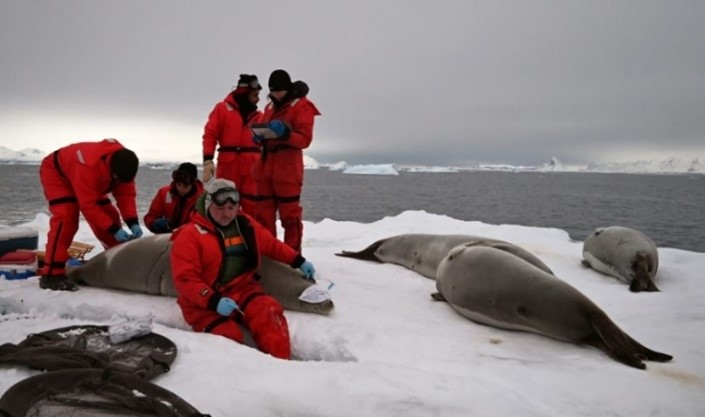Pinnipeds (Seals, sea lions and walruses) are a widely distributed and diverse group of marine mammals. This #WorldSealDay we talk to Dr Luis Huckstadt, Senior Lecturer from the University of Exeter, Centre for Ecology and Conservation about his work on pinnipeds around the world. Read on for more:
Dr Luis Huckstadt
Hi Luis. Tell us a bit about your background and how you ended up researching seals!
I decided that I wanted to work with marine mammals when I was a kid. I was one of the few children who knew from age 12 that I wanted to be a marine biologist and work with marine mammals. My career was focused on that from day 1. I am from Chile originally and I did my undergraduate degree at the Universidad de Concepción in Marine Biology, followed by my Master’s in Oceanography. I started working with pinnipeds while I was doing my undergraduate course and my thesis was on the interactions between fishers and Southern sea lions in Chile. That research project continued for my Masters. After that, I got a Fulbright Fellowship and went to do my PhD at UC Santa Cruz in California, where I worked with one of the biggest labs studying pinnipeds in the world. That gave me the opportunity to expand my research. I started working with northern elephant seals, Californian sea lions, Galapagos sea lions, South American sea lions, crabeater seals in Antarctica, Weddell Seals in Antarctica and southern elephant seals. This means I travel all over the place for my work.
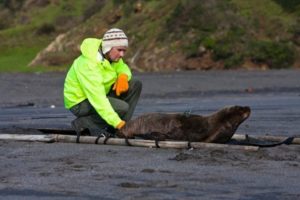
Tagging South American sea lions. Credit: Luis Huckstadt
I originally started working on the topic of pinniped interactions with fishers but since then I have moved onto more pure ecology. I am interested in the foraging behaviour of pinnipeds, how they move, how they find prey, and the associations we can draw between their presence and the environmental covariates. I work a lot in Antarctica – currently I am working on two projects where we are researching Weddell seals and crabeater seals. We have also just had a new project funded where we will work on southern elephant seals in Chilean Patagonia.
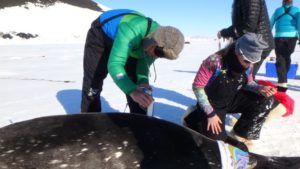
Measuring the blubber of Weddell seals. Credit: Luis Huckstadt
After I finished my PhD I did a couple of post docs in Santa Cruz and I moved to the University of Exeter last year. Since moving here, I have started a project on the local population of grey seals in Cornwall and I also have a collaboration going on with the Sea Mammal Research Unit up at St Andrews University where we are working on the foraging ecology of grey seals and common seals on the Shetland Islands and in eastern England.
Tell us all about your work with seals in Antarctica:
I work on a project funded by the National Science Foundation in the US – it is a big collaboration between ourselves, the University of California Santa Cruz, the University of North Carolina, Wilmington and the British Antarctic Survey. The idea is to try to understand how climate change is impacting the crabeater seal off the coast of the Antarctic Peninsula.
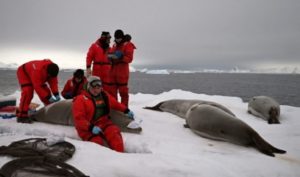
Studying crabeater seals in Antarctica. Photo Credit: Dan Costa
Crab eater seals are probably one of the most highly specialised species of mammals on the planet. 98% of their diet is Antarctic krill alone. They have very highly modified teeth that work as a sieve to actually filter krill out of the water. So this species depends on this one important resource, which is one of the most abundant animals on the planet its true, but we do not know how climate change will affect both their relationship between their prey and the environment. These seals are dependent upon krill to feed exclusively but they also need ice. They are what we call pack-ice seals and they need this substrate to haul out, to moult, to rest, to breed, etc. The West Antarctic Peninsula is one of the fastest warming parts of the planet. It is well above the average. Because of that, we have seen a dramatic change in the sea ice extent. What we think is happening is that these two main habitat requirements, the ice and the krill, are separating apart. As the ice moves further back and the krill potentially do not, the crab eater seals are likely to have to move farther to get to their prey and that incurs higher energetic costs for this species.

Aerial photo of crabeater seal studies in Antarctica. Credit: Luis Huckstadt
To answer this question, we have a project where we are deploying satellite tags and behavioural tags on crabeater seals to monitor their movement patterns and their diving behaviour. The tags transmit the data through satellites. We are also doing a series of measurements on every individual that we capture including diving physiology. So, we are estimating how much oxygen they have in their bodies and their body condition. We are also using drones to validate our assessments of body conditions at the entire population level. Additionally, we are using stable isotopes to look at the foraging ecology, to see what they might be incorporating into their diets. We are doing this along a latitudinal gradient along the peninsula. So we are going to the northern tip of the Peninsula and then as far south as we can. We would predict that the animals in the north are doing worse than the animals in the south and we want to see if that is the case.

Taking measurements of body condition of crabeater seals in Antarctica. Photo credit: Matt Cabell
We had our first field season last year, which unfortunately didn’t go very well because there was no ice. Last year was the lowest sea ice occurrence on record, this year is even lower. We are crossing our fingers that things will get better in the next two months because we’re supposed to be down there in May/June which is the start of winter in Antarctica. This has been a very dramatic year in terms of sea ice. We might get some good data but our sample size might be limited because we can’t really get to the seals. So, we’ll see what happens this year! We will be down in Antarctica for 2 months studying the crabeater seals. We’ll also take samples of fish and krill to understand the prey dynamics and sample phytoplankton to understand the productivity that these animals depend upon.
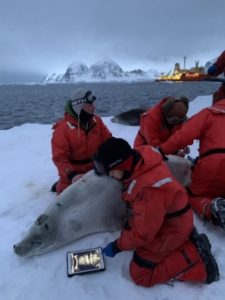
Taking measurements of body condition of crabeater seals in Antarctica. Photo credit: Matt Cabell
Our collaboration with the British Antarctic Survey will take things to the next level, which is where we will use remote sensing technologies to study both the distribution and abundance of crab eater seals and their body condition. We’ll be flying drones all over the peninsula so we will be able to tell on a larger scale, on a populational scale, what’s happening with the animals from north to south. We’re also using high resolution satellite imagery to count the number of seals which is something that we can use to estimate population size for crabeater seals in Antarctica. We don’t currently have a good estimate of how many there are – we know they are the most abundant species of seal and probably the most abundant species of non-domestic large mammal. But because of the difficulties to get to Antarctica and the technologies we have available, the confidence interval in our population estimates for crab eater seals are off the charts. We know that there’s somewhere between 7 and 15 million of them but the variance there is huge and we have no idea how many there are exactly. Hopefully by using this high-resolution satellite technology we can conduct a census of the entire population on the Antarctic continent.
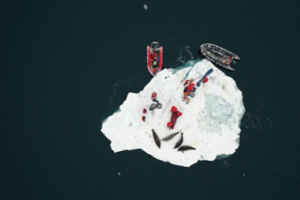
Aerial photo of crabeater seal studies in Antarctica. Credit: Luis Huckstadt

